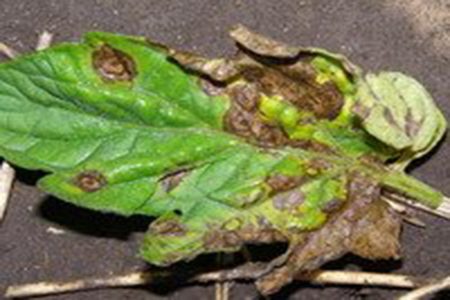Quy trình sử dụng thuốc BVTV
EARLY BLIGHT IN TOMATO – IDENTIFICATION AND TREATMENT
Posted On
August 7, 2017
at 9:33 am
by lovetadmin / Comments Off on EARLY BLIGHT IN TOMATO – IDENTIFICATION AND TREATMENT
Tomato blight, in its different forms, is a disease that attacks a plant’s foliage, stems, and even fruit.
Early blight (one form of tomato blight) is caused by a fungus, Alternaria solani, which over-winters in the soil and infected plants. Affected plants underproduce. Leaves may drop, leaving fruit open to sunscald.
Early blight’s Latin name is sometimes confused with a form of tomato rot, alternaria, a different tomato problem altogether. To muddle matters further, early blight is occasionally mistaken for Septoria leaf spot because the two diseases infect tomatoes at the same time.
What does early blight look like?
-
Dark, concentric spots (brown to black), ¼ – ½” in diameter, form on lower leaves and stems. Early blight is marked by tell-tale rings.
-
Fruit can also be affected; spots often begin near stem of fruit
-
Lower leaves turn yellow and drop

When does early blight affect plants?
-
It’s most evident during early- to mid-season
-
It’s most common in humid weather
-
It often strikes after a period of heavy rainfall
How do you control and treat early blight?
-
The best control measure for tomato blight is prevention (see below).
-
Remove and destroy infected leaves (be sure to wash your hands afterwards).
-
Once blight is present and progresses, it becomes more resistant to biofungicide and fungicide. Treat it as soon as possible and on a schedule.
-
Organic fungicides. Treat organically with copper spray, which you can purchase online, at the hardware store, or home improvement center. Follow label directions. You can apply until the leaves are dripping, once a week and after each rain. Or you can treat it organically with a biofungicide like Serenade. Follow label instructions.
-
Chemical fungicides. Some gardeners prefer chemical fungicides, the best of which for tomatoes is chlorothalonil (sold as Fungonil, Daconil, or under other brand names. Check labels. You may also choose Mancozeb or Maneb, although these have longer wait times before you can harvest tomatoes safely than does chlorothalonil.
Other diseases (such as late blight, Septoria leaf spot, and gray leaf spot) can also be controlled by these biofungicides and fungicides, so application is multi-purpose.
How do you prevent early blight?
-
Rotate crops. Early blight remains active for a year. Spores can be dormant in the soil for several years.
-
Plant disease-resistant hybrids to strengthen your plant’s chances of being blight-free.
-
Plant tomatoes in a raised bed to improve drainage and prevent diseases from spreading.
-
Give tomato plants extra space (more than 24 inches) to let air to move among leaves and keep them dry.
-
Water the soil – not the plants – to prevent splashing. Avoid overhead watering.
-
Mulch with black plastic or landscape fabric to prevent fungus from spreading up onto leaves.
-
Stake tomato plants for better circulation.
-
Remove and destroy affected plants at the end of the season.
Information contact: +84933067033

